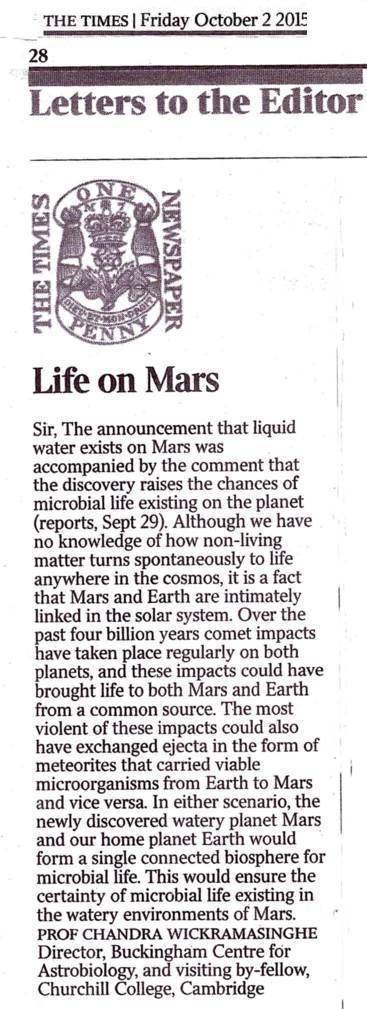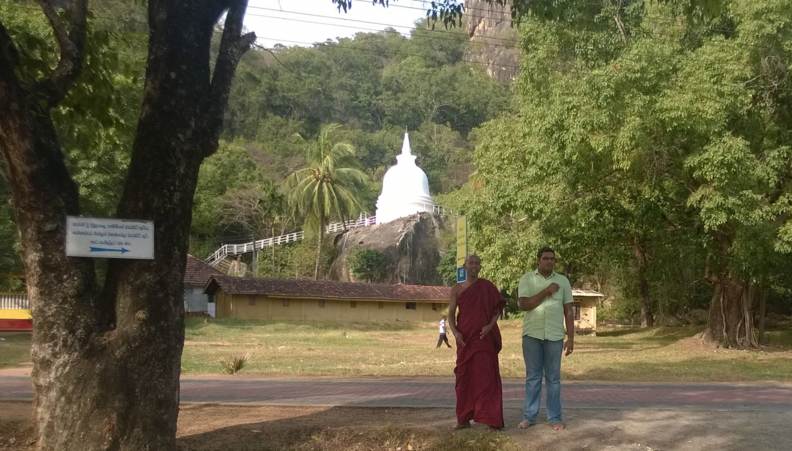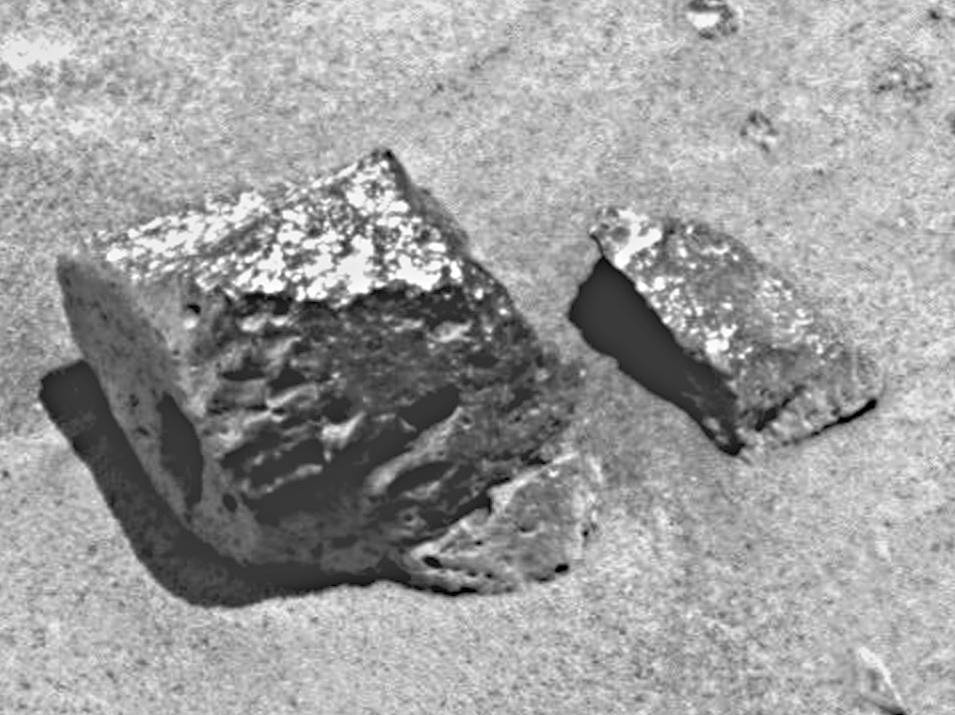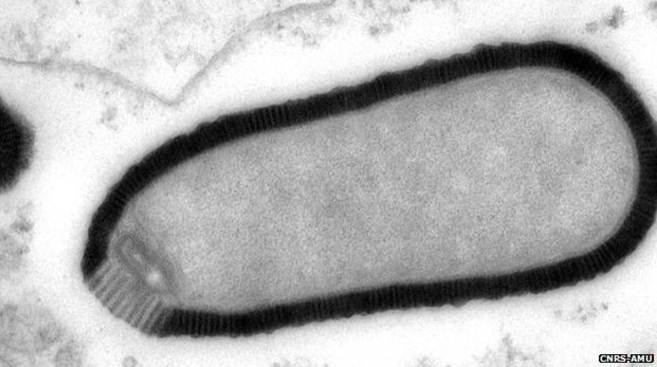COSMIC ANCESTRY | Quick Guide | Site Search | 2016 - Replies Index - 2014 | by Brig Klyce | All Rights Reserved |
|
...Look, the emperor has no clothes.... Somebody has to say it — James Shapiro, p 12, The Paradigm Shifters, 2015.
Replies to Cosmic Ancestry, 2015Seth, thanks for being a fb friend. I wanted to follow your postings. I seldom post anything, but I did post this link when it was current [26 Jul 2013]:
Sun 3:34 PM: Hi, Brig, I get pareidolia emails just about every day. If there was life on Mars (or still is), it would most likely be microbial. If complex life had evolved, you would see evidence all over the place. Did you look at this fossil? Or the [related posting] at Sun 7:26 PM: Well, Brig, there are claims of sea creatures, crabs, Nazi helmets, statues of women, and all sorts of other things in the photos from the Mars rovers. But you can also see equally convincing shapes in clouds. Doesn't mean a thing. It's our brains, not life on Mars. ... and you might want to check out this example: Why Your Brain Thinks This Picture Shows a Giant, Martian Crab Monster. It's called 'pareidolia' Mon 8:47 AM: I can't tell if you even looked at the fossil. Nothing you mention is equally convincing to me. Would you be willing to spend 60 seconds looking at it, and tell me what nonbiological process could produce it? Mon 11:59 AM: I did look at it, Brig. And asked others to, as well (Mars geology is kind of a specialty here ...) It's natural geology, and probably didn't even require any water to produce. Tue 11:14 AM: Thanks for looking. If you find a nonbiological structure that resembles it more than the crinoid fossil at the Harvard Museum, please show it to me. ...Or maybe ask a biologist to look at the Martian fossil? Thank you! Chat Conversation End...I work at a Federal Laboratory and any mis-use of my name as recommending any product is illegal. To be clear, I do not make any such recommendations on websites or in any advertising of any kind (individual, organizational, institutional, and professional), and ask that you correct this entry asap on your website by removing my name wherever it may appear for an endorsement of any kind (explicit or implicit).... 4:58 PM: ...I thanked you for making the October [Astrobiology] issue available. ...No one will be confused.... 01 Dec:...I'm wondering now whether this may be a matter I need to bring to the attention to the lawyers at PNNL.... 2 Dec: Dear Ms. Cady -- Occasionally I get email suggesting or demanding that I "correct" my website. If there is a factual error, I correct it and thank the sender. Otherwise, if the message explains a different opinion, [sometimes] I will post it and link to it. If the message is a mere rant, I ignore it. I must confess, I initially had you in the rant category. Still not convinced, but in case I'm wrong, I have posted your disclaimer and linked to it from your name. If your concern is honest, this should take care of it. Best regards, Brig I enjoyed this article as it referenced the Mawangdui Silk which is as close to a smoking gun for the comet/virus connection as you could get 2,000 years ago.
Dear Brig, I thought of updating you on progress. We returned from a very interesting meeting in Karagpur IIT on Science, Technology and Spirituality. Vedantic philosophy dating back to over 4000 years appears to be remarkably consonant with our views about panspermia and cosmic life. It rejects abiogenesis and considers life to be an eternal component of the Universe. You are recently aware, no doubt, of 3 independent developments that support our views. First, the oldest biogenic carbon in zircons now goes back to 4.1 billion years BP. Next, the production of ethyl alcohol and a sugar in a comet (Lovejoy) is an indication of fermentation processes within the comet. Finally, the combination of equal amounts of water and O2 has an explanation on the basis of cyanobacterial photosynthesis, harnessing the low light levels near regions just below the surface of comet CG.... Best Wishes, Chandra [PS:] I forgot to mention that Richard Hoover phoned with some excitement a few days back to say he had obtained decisive and compelling evidence from his investigations in Russia, showing that the diatoms were of extraterrestrial origin. ...Also there is some excitement about a piece of Apollo 10 landing near the coast of Sri Lanka on 13th November. We are trying to secure a fragment of it for examination. Prof. Chandra Wickramasinghe | Visiting Fellow, Churchill College, University of Cambridge | Director Buckingham Centre for Asrobiology | www.buckingham.ac.uk/research/bcab | www.profchandra.org | www.ispajapan.com Brig, Thanks for the link to Richard Hoagland's research on the crinoid. Yes, I know about Richard's fossil analysis. As important to me, is the photo of the "slot rock" [pictured below/click to enlarge/close to return] as Richard described it from the Spirit Landing Site. However, that was not my analysis. I believe it to be a petrified cypress tree trunk that was excavated by an impact or was translocated into the the area by the tributary that led into the basin; as NASA describes the area. This area, or the area upstream, was a wetland. As you know, petrified wood is a fossil. It forms when plant material is buried by sediment and protected from decay by oxygen and organisms. Then, groundwater rich in dissolved solids flows through the sediment replacing the original plant material with silica, calcite, pyrite or another inorganic material such as opal. The result is a fossil of the original woody material that often exhibits preserved details of the bark, wood and cellular structures. There are numerous examples of this type of thing around the United States. The description from NASA of the lading site: "Spirit landed on the opposite side of Mars from its twin, Opportunity, in Gusev crater, a 170 km diameter crater which formed three to four billion years ago. A channel system drains into the crater that likely carried liquid water, or a combination of water and ice, at some point in Mars' past. The crater appears to be an old lake bed filled with sediments. It was hoped that sedimentary material from this early era could be studied, although at first the region proved disappointing in its lack of available bedrock on the flat lava plains of the crater. Spirit eventually made its way to the Columbia Hills, a small group of low-lying hills about 3 km from the landing site, and rocks examined there do show evidence of interaction with small amounts of briny (salty) water." This description is consistent with my analysis. I am not sure if Richard agrees or if he considers the image to represent an 'artifact'. So as not to put words into his mouth, I am taking the liberty of cc'ing Richard this email. I am sure he would be interested to know that you have mentioned his analysis of the crinoid on the www.panspermia.org website. As always, kindest regards, Ron
Dear Brig, Thank you for your interest on our paper. I cannot really agree with the comment you posted. The fact that the genes required for symbiosis in land plants are present in algae does not mean that they did not have any adaptive advantage (i.e. selection pressure) in those organisms. We do not know yet the role they play in algae but we are investing it now. This is a clear example of genes having a function in a given context that is recruited in a new environment via classical, Darwinian, evolution. Could you edit your comment to reflect that? Please do not hesitate to let me know if you have any question. Thank you, Pierre-Marc 10:29 AM: Dear Pierre-Marc -- Thank you for your reply! I cannot edit my own opinion to yours, but I can post yours and link to it from mine.
I understand the darwinian suggestion (for this and many related examples) to be that the genes had 1) an original, as-yet-unknown role in their earlier species, and 2) a fortuitous second function, unshaped by natural selection, useful in a later-evolving species. This is new conjecture, invented to fit the surprising facts, and implausible on its face. But I welcome you to rebut these words of mine, and I will post whatever you say, if you would like. I believe there is an important issue here.
Thank you again for the response, and thanks for the original research. ...Very best regards, Brig

Dear Brig ...I thought I'd let you know that the Bingley event [honoring Fred Hoyle] is now fixed for 19th November. We spent the last week in Cambridge and also hope to be their from this Wednesday for a week. Many colleagues I talked to at high table seemed convinced that our once heretical ideas are now mainstream (an erroneous perception of course!). The attached letter from me [right] was the lead letter in the London Times of a few days back.... Best Wishes, Chandra Prof. Chandra Wickramasinghe | Astrobiology website: http://www.buckingham.ac.uk/research/bcab | Personal website: http://www.profchandra.org Brig, here is a peculiar twist on HGT -- not that fetal DNA gets incorporated into mom's DNA, but that the fetal cells that get incorporated into mom's body apparently do affect her physiology and so could influence evolutionary outcomes. This is slightly off target from your HGT interest, but close enough I thought you'd be interested – a kind of retro-inheritance: not parent to offspring but the other way around. ...Ken
...The Monastery was amazing - Met Buddhist monk who had actually seen the disputed Polonnaruwa Meteorite.  Olá a todos, (Hello everyone,) Talvez vos possa interessar este novo trabalho que acabou de ser publicado. (Perhaps you may interested in this new work, which has just been published.) Com amizade, (With friendship,) Francisco Carrapiço | The Azolla Page Hello Brig, This is Meghan Rouillard, I met you a couple of years ago at the NASA Astrobiology conference where I was doing a poster presentation on his work vs. that of Alexander Oparin. Recently I completed a new English translation of Vernadsky's paper "The Study of Life and the New Physics." Here is a link to get a copy: http://bit.ly/vernadsky-new-physics. I haven't checked out your site recently, but one of my colleagues mentioned it recently and I will definitely look at what's new. Regards, Meghan Rouillard | 21st Century Science and Technology PS: I have also made a public facebook page for Vladimir Vernadsky: https://www.facebook.com/pages/Vladimir-Vernadsky/1604028986548227?ref=hl. Mr. Klyce, just want to bring to your readers' attention that today is Fred Hoyle's 100th birthday. Hoyle remains a key part of my own teaching and scholarship, but even more has been my inspiration for how science should be done in terms of how he chose to work on problems at the forefront of astronomy and astrobiology. He figured out how and where the carbon in all living things was generated. He picked up the challenge, with Chandra Wickramasinghe, of how all living things on Earth might have come to be here. Courageous and revolutionary in his science, and now being shown to be right about the origins of life on Earth, Hoyle is the definition of the great and immortal scientist. I am poorer for not being able to meet him years ago when I invited him to visit my college--graciously deferring citing his age. But I cherish his personal letter. Still I feel like I know him intimately from his work with Wickramasinghe. It has been my luck and more than enough that he will always be close and alive to me. Dr. George Nickas (ret.-Hanover College), Madison, Indiana FYI : # DarkLife @nanobacteria a new limb on the tree of life? We need dedicated, deep-underground laboratory in the U.S.
Brig, here's an interesting statement tucked away in this Science review: "In fact, our present understanding of morphogenesis indicates that new phyla were not made by new genes but largely emerged through the rewiring of the gene regulatory networks (GRNs) of already existing genes" This observation is startling, all the more so for being tossed off so casually. I know this is familiar ground for you, but let me editorialize: Evidently, we can say that the genes for descendant species were there already in remote ancestors, or that the GRNs for descendant species were there already, or both were there already. In any case, what were they doing there? If they were not yet expressed in the ancestral species, what were they doing there? Were they silent passengers that just happened to be adaptive when expressed in descendants? That seems far fetched. But it all makes sense and is to be expected if evolution is a case of development, with epigenetic mechanisms regulating the differentiation of species in some manner similar to that in which such mechanisms regulate the differentiation of cells during ontogeny, or development. Compare quoted passage to this, "In fact, our present understanding of cellular differentiation in developing organisms indicates that new cell types are not made by new genes but largely emerge through the rewiring of the gene regulatory networks (GRNs) of already existing genes" But if evolution is an instance of development, then what kind of creature is developing?
Dear Professor Klyce, The mars exploration rover Curiosity recently sampled nitrogen in the soil of Mars. Here is the link to the announcement: http://www.jpl.nasa.gov/news/news.php?feature=4516 Albeit NASA concludes this further elevates Mars as a habitable zone for organisms and the nitrates are in a form usable for known organism, NASA prefers instead to argue for a delivery by meteorites scenario, which does seem to be a good fit with the observed quantities. Based on the presumed fossil appearances, the findings from the Spirit exploration rover hinting on a higher oxygen contend in the Martian atmosphere some 3.7 billion years ago, the similarity of terrain features with fossilized biofilm strata (Noffke), the Viking data (Levin et al, which should have been reevaluated in any case with finding of methane because it was ruled out back then for the lack of detection of organics) and the initial studies on ALH48001 (McKay) and the special topology of some Martian (presumed) craters (including Gale) I think a case could be made for the nitrogen actually being a trace of earlier biogenic activity. I am still curious about the high concentrations of argon 40 and think it would possibly useful to do some comparative work to terrestrial marine strata. ...The answer can only elude us for so long :) For your information. Best regards, Sascha Wageringel
Dr. Klyce, I am passing on this article to you and possibly for your readers on Cosmic Ancestry. Plague outbreaks that ravaged Europe for centuries were driven by climate changes in Asia, The Conversation, 23 Feb 2015.
Dr. George Nickas | Madison, Indiana
Dimitar Sasselov's Online Course on Alien Life Available February 10 from Amanda Preston | 3 Feb 2015 Dear Dr. Klyce: As someone who has some familiarity with the Harvard Origins of Life Initiative, directed by Professor Dimitar Sasselov, you may be interested in the exoplanet learning opportunity described below. Super-Earths And Life, an entirely online interactive course taught by Professor Sasselov, will begin on February 10, 2015. This interactive course is about alien life, how we search for it, and what this teaches us about our place in the universe. Super-Earths And Life is offered at no charge through EdX, a new nonprofit virtual learning platform founded by Harvard University and MIT. Full information on this online course is available at: [information]. Registration details can be found at: [registration]. Please feel free to share this message with friends and colleagues who are interested in the search for habitable planets. With best regards, Amanda Preston Amanda Preston | Executive Director |
COSMIC ANCESTRY | Quick Guide | Site Search | 2016 - Replies Index - 2014 | by Brig Klyce | All Rights Reserved |



